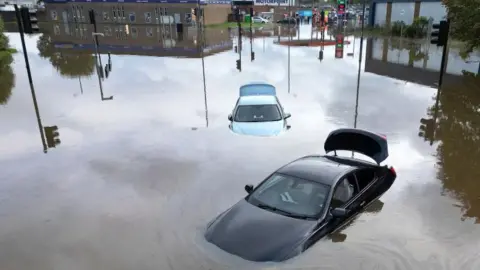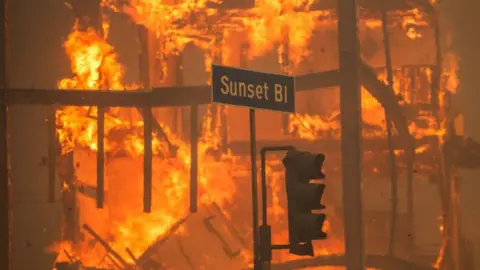Technology Reporter
 Getty Images
Getty ImagesWhen the storm hit the town of Trool in Nottingham in 2023, Claire Sandden believes his house will not be affected.
Nevertheless, when he bought the property in 2021, he was told by the State Agent that a year ago a flood, which had reached the property but did not affect it, was one time in a life, and that flood measures would be kept in place to protect the properties on Total-D-saak.
However, two years later, the storm chapted in the UK, Ms. Sandden’s house flooded after several days of rain.
“We knew that there would be water on the total Dak, but no one was expected to flood it internally. However, the water entered the property for five hours.”
“It reached the upper part of the scratching board. We had to replace all the floor, wood work and lower kitchen, which took about 12 months.”
His last insurance bill was about $ 45,000.
She says she was fortunate that she qualified for a government scheme that provided affordable insurance to homeowners in high flood -threatening areas.
Although she loves the area, her neighbors and home, the weather is now the cause of stress. “We are permanently concerned about the weather, if it’s raining more than two days or there is a designated storm.
“We wish we have taken further steps to understand the danger. The survey showed that the property is in the medium flood zone but there is no detail other than the maps of the flood zone.”
 Claire Sandden
Claire SanddenIs climate change Increase the possibility. And the severity of natural disasters such as floods, forest fires and hurricanes.
Although Ms. Sandden and other landlords may be too late, new tools are being prepared to help people and companies assess the climate risk.
Last December, the UK Environment Agency updated its national flood risk assessment (NAFRA), showing the risk of current and future floods for England with rivers, sea and surface water.
He used his data along with local authorities and climate data from the Met Office.
It also made the latest map of national coastal erosion (NCERM) the latest. The two were last updated in 2018 and 2017 respectively.
New NAFRA data shows that more than 6.3 million properties in England are in areas that are at risk of flooding with rivers, sea or surface water, and with climate change can increase to 8 million by 2050.
“We have spent the best available data, changing our understanding of flooding and coastal hazards in England, highlighting the best available data … as well as improving modeling and technological growth,” said Julie Fuley, director of flood risk strategy in the Environment Agency.
“When we calculate the latest climate estimates, one out of four properties may be at risk of flooding in these areas by the middle of the century.”
The Environmental Agency plans To launch a portal Where users can examine the risk of their long -term floods.
Similar resources are available through ABI for Scotland, Northern Ireland, and Wales.
“We can no longer rely on historical figures,” says Loki Ahmed, co -founder of the X -X -X.
The London -based climate firm offers a digital twin of the earth, which imitates different events of the weather and their potential effects under various emission scenarios on their properties, infrastructure and assets.
It connects artificial intelligence with physics -based climate models.
“Although many climate models can tell you how much rain will be expected, they do not say what happens when the water is hit by the ground.”
“Our models, for example, what happens when water is hit, where it travels and what will be the effect of flooding.
Although bank lenders are examining their products, property companies are currently using their services while considering new developments.
Mr Ahmed says, “They log in to our platform and identify locations and current building stocks, and in return they receive the risk of risk rating and severity.”
 Getty Images
Getty ImagesMany parts of the world have a far more season than the UK.
In the United States in January, destructive wildfire flashed Some parts of Los Angeles. Meanwhile Hurricane Milton, who landed last October, is likely to have one of the The most expensive hurricanes to target Western Florida.
NEW, New York -based Fora homes and commercial buildings, to help insurers handle these costs.
“We look at the various elements of a property to understand how much the property’s flexibility and survival are likely to be identified,” says Fora co -founder Walky Holmes.
“We tell companies and homeowners whether their property will stand after the destruction, not only whether there will be any catastrophe in an area,” he added.
Fora sets its studies on data through satellite and aerospace and surveys and disaster reports.
Mr Holmes says “insurance companies have technically data so that they can do it but have not developed models to correct the quantity.”
 Redifon
RedifonOther services are popped up for domestic buyers. For the marketing of these properties, the US firm Redphon estimates the possibility of percentage of natural disasters, such as floods and forest fires, in each property for the next 30 years.
“If people are looking at two houses in the same neighborhood in the same neighborhood, the risk of climate (their decision) will make or break,” says Daryl Fair Weather, the chief economist, said.
As far as Ms. Sandden is concerned, after her personal experience, she now works for the Flood Risk Company FPS Group.
“The risk of flooding is just worsening in the years to come, so it is important that you know more about the risk of flooding a property.”
“Floods have a huge impact on communities and mental health. You should feel safe in your home, it should not be a place of anxiety and anxiety.”



